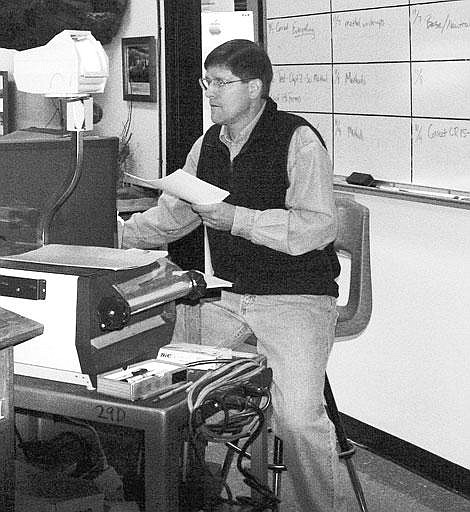Environmental health science class studies air quality
Carol Holoboff Western News | Hagadone News Network | UPDATED 18 years AGO
Words like particulate, microns, ozone, alveoli and volatile organic compounds fly across the room when students at Libby High School are discussing ambient air issues in Gene Reckin's environmental health class.
Twenty-one of the students, in the class of 25, are girls. Reckin said girls make good scientists because they are so detail oriented. In 1950 girls were excused from "hard science" classes and satisfied the science credit requirement by taking home economic classes where they learned to can peaches and sew aprons.
The students in Libby are studying a type of air pollution called particulate matter. Particulate matter (PM) is a mixture of solids and liquid droplets in the air. A particulate matter with a diameter of 2.5 micrometers, or less, is called a "fine" particulate, and is a greater threat to human health.
Alyssa Sweeney, Sperry Robinson and Trista Berget are just three of Reckin's students who have, through some kind of osmosis, absorbed his enthusiasm for scientific inquiries.
Sweeney's paper titled, "A Study of the Correlation between Indoor and Outdoor Air Quality and how location Affects levels of PM2.5 Concentration," asks if the outdoor air quality is higher at a certain testing site, then will the indoor air quality correlate accordingly and also be higher on a given day.
Sperry Robinson will present "The Effects of Different Wood Species Burning in Woodstoves on Indoor PM2.5 Levels," which will ask if the levels of PM2.5 measured will change when different species of wood are burned.
"A Study of the Correlation between Indoor and Outdoor Levels of PM 2.5 and Proximity to Particulate Emitting Sources" is the title of Trista Berget's paper. Berget questions if a home is near a particulate emitting source, will the PM 2.5 levels around that home be higher than homes not near a particulate emitting source, and if the levels are increased around the outside of the home, will the levels of particulate matter increase on the inside as well?
Air Toxics Under the Big Sky, a program developed in 2004 by Dave Jones, a chemistry teacher at Big Sky High School in Missoula, allows students to work alongside University of Montana professors and scientists to examine certain components of air pollution. Increased financial support has allowed the project to expand to several additional schools, one of which is Libby High School.
Sawdust is a large particulate that our respiratory system traps in mucous and brings up with coughing or is caught in our nasal passages. Tiny, even unseen particles, can get into the alveolar (air sacs) in our lungs. Wood burning is just one of the sources of primary particles. Pollution also comes from many other sources, for example, sulfur dioxide, coal plant exhausts and car exhausts add particulate matter to the atmosphere. However, 82 percent of Libby's particulate matter is from wood smoke combustion.
Reckin's students are looking at how different kinds of wood, different methods of house cleaning and different heating sources alter particulate matter.
An instrument called a DusTRAK monitor measures particulate matter in microns. The monitor can be placed in a home and set to read the air quality at certain times of the day. The data collected by the DusTRAK can be sent to a computer where graphs are created to indicate peaks and valleys in measures of particulate.
Family, friends and neighbors have volunteered to participate in the student's projects. They are asked to fill out a questionnaire for UM as well as a questionnaire developed by Reckin's students which asks questions pertinent to their particular project, such as what types of wood do they burn in their stove.
Some students are also looking at air quality outdoors. Using a GPS they hope to create an airshed map that would indicate areas of intensity in the valley. Another student is tracking the air quality in his car. He is measuring the PM 2.5 when the car is cold or warmed up, using re-circulating air or fresh air, and when the windows are down or up.
The projects are not only getting the students to think scientifically, but to use methodology to arrive at an answer rather than just guessing,
The students will travel to Missoula and participate in a symposium at UM next spring. They will present their papers and the results of their studies and compete with other high school students from around Montana for awards and cash prizes.
ARTICLES BY CAROL HOLOBOFF WESTERN NEWS
Lack of funding pushes EPA project back
The Environmental Protection Agency's Region 8 Work Plan for 2008 does not include the clean up and abatement of the green and tee boxes at Cabinet View Country Club because of insufficient funding.
Baucus pursues funding for golf course cleanup
Sen. Max Baucus believes the vermiculite found at a Libby Elementary School last week is a perfect example of the need for Libby's asbestos exposure to be declared a public health emergency.

Home is where the heart is; African girl finds family in Troy
Florence Laflin is at home in Troy. The stork didn't bring her, but she did come on a big iron bird. She flew on an airplane from Monrovia, Liberia to her new American family in Montana.

